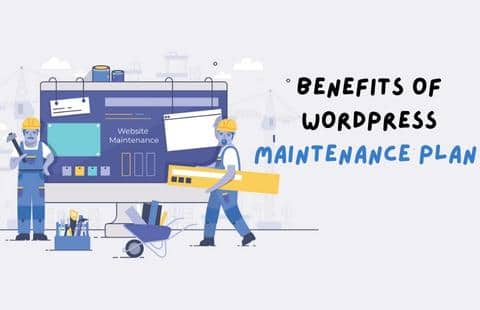- December 9, 2022
- techAdmin
- 0
Top 5 Reasons to create a WordPress Maintenance Plans
There are many moving elements in WordPress. Being a business owner and simultaneously maintaining all the various facets of a WordPress site may rapidly become overwhelming. That’s why every web development has this WordPress Maintenance plan.
Do you want your WordPress site to run smoothly?
Having a good WordPress Maintenance Plan will ensure the best performance of your site at all times, as it helps to break down the tasks into manageable steps.
This article will cover five reasons you should create a WordPress maintenance plan and what a good one will look like.
How a WordPress Maintenance Plan will benefit you?

Keep you updated on new WordPress versions
There is a need to be alert to the new updates of WordPress versions as they are released frequently. These updates strengthen the essential operation of WordPress and fix security issues.
Creating a proper WordPress maintenance plan and following it with regular checks for updates will make your site prepared for any changes to the WordPress structure.
Plugin and theme developers also release regular updates to their products. These updates often fix security holes, introduce new capabilities, and maintain the plugin or theme compatible with the most recent release of WordPress. However, upgrades to WordPress plugins and themes may lead to conflicts with already-existing components of your website.
An essential part of a WordPress maintenance plan is creating a hidden stage setting from where to test out plugins and theme updates. This way, you can ensure that nothing will fail, that the plugin fulfills your requirements, and that it will be compatible with your WordPress site.
A conflict with other plugins or an active website theme is easy to see, but the solution is tough to find. The plugin developer may not be helpful as they aren’t aware of your website’s specifics and the other plugins you use. A WordPress troubleshooter can quickly solve the issue and build a maintenance plan to prevent a similar situation.
Site Security
WordPress is one of the most using CMS on web software, but it is also the most hacked, making up for 83% of compromised CMS platforms. Notably, outdated WordPress sites cause 44% of the hacks.
A good WordPress maintenance plan checks for any security errors in your website and takes the required precautions to mitigate them. There are several ways to protect your WordPress website, such as selecting a reliable hosting company, setting up a firewall, and getting an SSL certificate. Using a top-rated WordPress security plugin is the easiest way to protect it against hackers.
A popular WordPress security plugin scans your website for malware and filters it out. Regular security checks like these are paramount, as a compromised WordPress site can damage your business.
Uptime Monitoring
Regular bouts of website downtime are undesirable. Suppose your site is down or doesn’t function optimally, preventing end-users from completing a task. In that case, it can result in reduced website traffic and loss of customers.
A good WordPress maintenance plan can do a task for calculating the amount of traffic coming through your site compared to the limitations of your hosting setup.
Uptime monitoring ensures that your site runs without issues, even when you increase website traffic. Each monitoring helps you to ensure your website is up to date and running with no problems.
Your WordPress maintenance plan has included steps to conduct the required checks to make your site more reliable and working properly.
Great user experience
A WordPress maintenance plan will allow you to spot any errors as and when they arise. You can ensure a smooth user experience by scanning your site regularly for broken links, images, and redirects.
An essential component of a good user experience and a significant ranking factor for SEO is Core Web Vitals. Core Web Vitals connect various aspects of your WordPress site’s performance to the user experience rather than focusing on generic metrics like website loading speed.
Core Web Vitals include metrics like Largest Contentful Paint Paint, First Input Delay, and Cumulative Layout Shift, all of which be monitored by a WordPress maintenance plan.
Core Web Vitals metrics are measurable SEO performance indicators that show how your users experience your website. You can utilize this information to concentrate on those areas of user experience that require improvement to attract repeat visitors and maintain low shopping abandonment rates.
Regular backups
A fundamental maintenance task of your WordPress site is Backups. Maintaining regular site backups is crucial as it will keep all of your website data in one place. The site may be restored if a security compromise or critical system fails.
You can do this in a double way: use a plugin like Updraft Plus that automates website backups or hire a WordPress professional to take care of your site’s security.
Updraft Plus is one of the most used free plugins that allow you to schedule automated backups, which are restored from your admin dashboard anytime.
Backups are scheduled every 2, 4, 8, or 12 hours daily, weekly, fortnightly, or monthly. If storing customer information and orders are included in your everyday business, it’s advisable to do backup as frequently as possible.
A skilled WordPress security professional can monitor your site security with more excellent protection than if you were to manage it yourself.
Ignoring WordPress Maintenance Plan Can Cost a Lot!
Resolving potential security threats and data losses takes a long time. Websites that have been outdated for a long time reach a stage where maintenance is no longer an option. They will almost definitely want professional assistance from a best WordPress development company, which will cost money.
As we all know, WordPress is evolving quicker than ever. Thus, if you wish for your website to perform safely at its optimum, you must have a WordPress maintenance plan.
